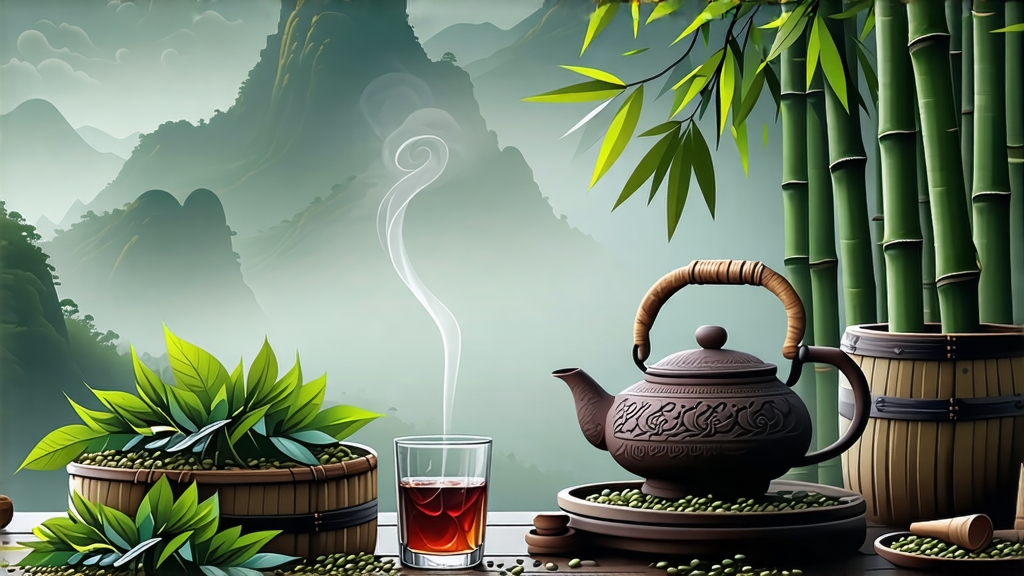
Tucked into the humid, karst-pocked mountains of southern Guangxi, Liu Bao tea has spent four centuries quietly perfecting the art of transformation. To the uninitiated it is merely another dark brick, but to the people of Wuzhou and to the Cantonese tea merchants who once floated it down the Xun River to the Pearl River Delta, Liu Bao is a living time capsule—an edible diary of climate, craft, and commerce. This essay invites the global tea lover to open that capsule, tracing Liu Bao from its Ming-dynasty birth to its twenty-first-century renaissance, decoding the micro-organisms that paint its flavor, and demonstrating how a single clay pot can coax a ruby liquor that smells of damp earth, sweet betel nut, and the leather saddle of a long-gone tea horse.
-
Historical footprints in misty mountains
The first written record appears in 1599, when a Ming garrison commander requisitioned “Liu Bao dark tea” as medicine for troops suffering jungle fevers. By the Qing, the tea had become currency along the Tea Horse Road’s southern branch: one liang of aged Liu Bao bought two liang of salt in Kunming, and a full bamboo-bound basket could swap for a sturdy Tibetan pony. The British East India Company logbooks of 1802 note “Lew Pao” arriving at Canton wharves, describing it as “black as coal yet sweet as fig,” a curiosity shipped to London alongside kegs of souchong. When the Pearl River silted up in the late nineteenth century, Liu Bao’s export window narrowed; the tea retreated into provincial memory, hoarded by grandmothers who believed it cured dampness and hangovers alike. Only in 2006, after the China-Asean Expo showcased a 1958 vintage brick that fetched US$30 000, did international interest reignite. -
Terroir: where limestone meets monsoon
Guangxi’s subtropical monsoon kisses the tea gardens 280 days a year. The bushes, mostly Qimen-cuttings transplanted in the 1850s, grow between 200–600 m on red lateritic soil laced with crushed limestone. The same karst that sculpts the Li River’s fairy-tale peaks also filters groundwater into mineral-rich springs. These springs irrigate the tea, loading the leaf with calcium, manganese, and fluoride—minerals that later feed the fungal consortia responsible for Liu Bao’s unique aroma. Locals insist that tea grown on north-facing slopes develops deeper “song xiang” (pine-resin fragrance) because slower photosynthesis concentrates terpenes. Whether myth or micro-chemistry, the claim underlines an intimate grower’s knowledge of slope, fog, and stone. -
From green to dark: the craft of pile-fermentation
Unlike shou Pu-erh that borrows Liu Bao’s technique, the Guangxi method predates it by two centuries. The journey begins with standard green-tea killing-green: leaves are pan-fired at 280 °C for four minutes to arrest oxidation, then rolled for 30 minutes to rupture cells. What happens next is the “dui wo” (pile-fermentation), a microbial rave that lasts 40–60 days. The leaf is heaped 70 cm high inside spotless cement bays, sprayed with mineral water until 38 % moisture is reached, and covered with jute sacks and black plastic. Internal temperature is monitored like a hospital patient: above 65 °C the pile is turned to prevent pasteurization; below 45 °C it is restacked to rekindle microbial fervor. Dominant players are Aspergillus niger, Blastobotrys adeninivorans, and a Guangxi-native yeast Candida liquanica that produces ethyl sotolon, the molecule behind the tea’s maple-syrup note. When the leaf turns chestnut-brown and emits a sweet, cellared-wine aroma, it is sun-dried on bamboo mats for three days, then steamed and pressed into 500 g baskets lined with bamboo skin. These baskets allow micro-oxygenation, so the tea continues breathing even while sleeping through decades. -
The three ages of Liu Bao
Fresh (1–3 years): liquor is apricot-orange, brisk with hints of green beans and raw walnut. Microbial activity is still violent;